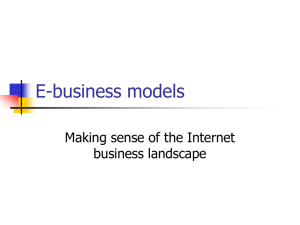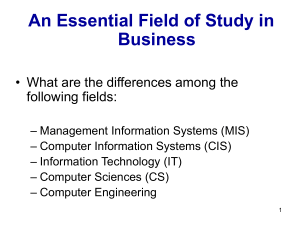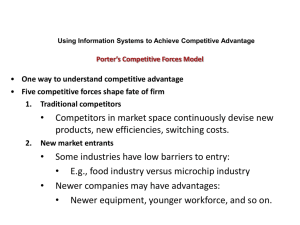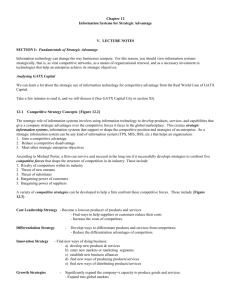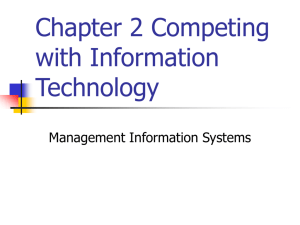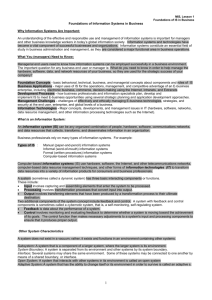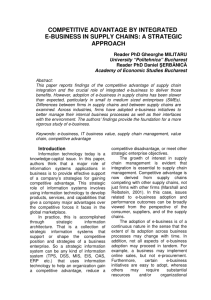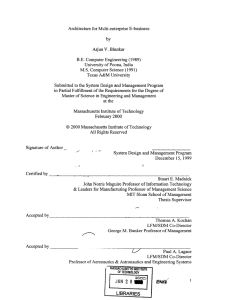CH 2: Competing with Information Technology
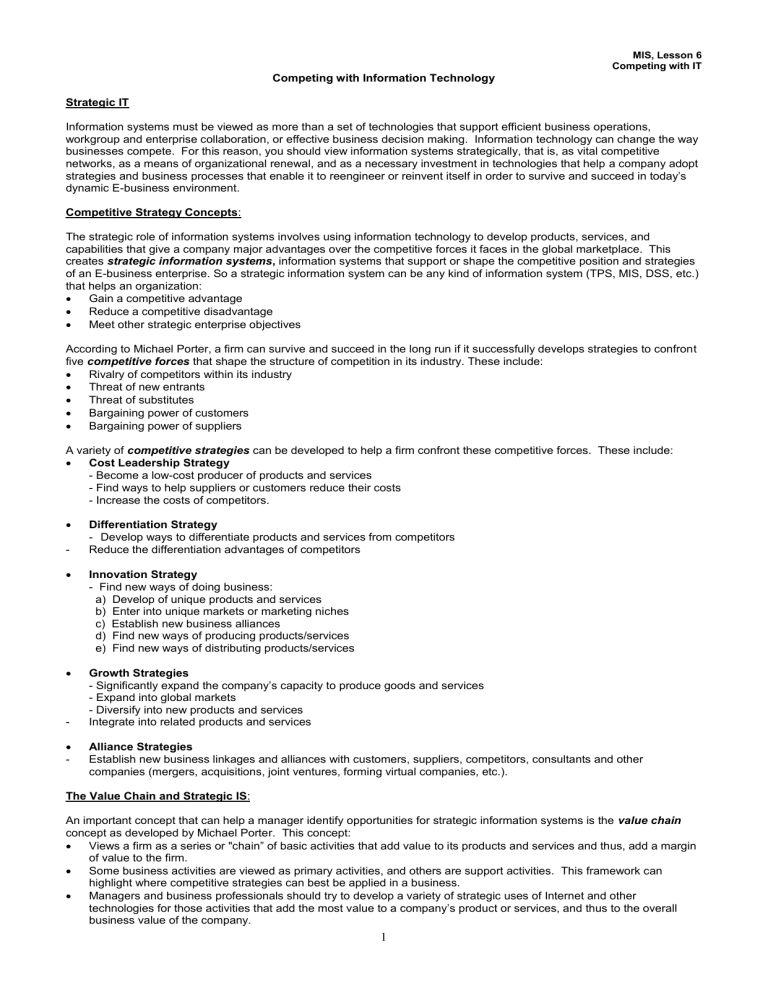
MIS, Lesson 6
Competing with IT
Competing with Information Technology
Strategic IT
Information systems must be viewed as more than a set of technologies that support efficient business operations, workgroup and enterprise collaboration, or effective business decision making. Information technology can change the way businesses compete. For this reason, you should view information systems strategically, that is, as vital competitive networks, as a means of organizational renewal, and as a necessary investment in technologies that help a company adopt strategies and business processes that enable it to reengineer or reinvent itself in order to survive and succeed in today’s dynamic E-business environment.
Competitive Strategy Concepts :
The strategic role of information systems involves using information technology to develop products, services, and capabilities that give a company major advantages over the competitive forces it faces in the global marketplace. This creates strategic information systems, information systems that support or shape the competitive position and strategies of an E-business enterprise. So a strategic information system can be any kind of information system (TPS, MIS, DSS, etc.) that helps an organization:
Gain a competitive advantage
Reduce a competitive disadvantage
Meet other strategic enterprise objectives
According to Michael Porter, a firm can survive and succeed in the long run if it successfully develops strategies to confront five competitive forces that shape the structure of competition in its industry. These include:
Rivalry of competitors within its industry
Threat of new entrants
Threat of substitutes
Bargaining power of customers
Bargaining power of suppliers
A variety of competitive strategies can be developed to help a firm confront these competitive forces. These include:
Cost Leadership Strategy
- Become a low-cost producer of products and services
- Find ways to help suppliers or customers reduce their costs
- Increase the costs of competitors.
Differentiation Strategy
- Develop ways to differentiate products and services from competitors
- Reduce the differentiation advantages of competitors
Innovation Strategy
- Find new ways of doing business:
a) Develop of unique products and services
b) Enter into unique markets or marketing niches
c) Establish new business alliances
d) Find new ways of producing products/services
e) Find new ways of distributing products/services
Growth Strategies
-
Significantly expand the company’s capacity to produce goods and services
- Expand into global markets
- Diversify into new products and services
- Integrate into related products and services
Alliance Strategies
- Establish new business linkages and alliances with customers, suppliers, competitors, consultants and other companies (mergers, acquisitions, joint ventures, forming virtual companies, etc.).
The Value Chain and Strategic IS :
An important concept that can help a manager identify opportunities for strategic information systems is the value chain concept as developed by Michael Porter. This concept:
Views a firm as a series or "chain” of basic activities that add value to its products and services and thus, add a margin of value to the firm.
Some business activities are viewed as primary activities, and others are support activities. This framework can highlight where competitive strategies can best be applied in a business.
Managers and business professionals should try to develop a variety of strategic uses of Internet and other technologies for those activities that add the most v alue to a company’s product or services, and thus to the overall business value of the company.
1
MIS, Lesson 6
Competing with IT
Examples:
Collaborative workflow internet-based systems can increase the communications and collaboration needed to dramatically improve administrative coordination and support services. Examples of support processes:
Career development intranet can help the human resources management function provide employees with professional development training programs.
Computer-aided engineering and design Extranets enable a company and its business partners to jointly design products and processes.
Extranets can dramatically improve procurement of resources by providing an online Ecommerce web site for a firm’s suppliers.
Value chains can also be used to strategically position a company’s Internet-based applications to gain competitive advantage. A company’s Internet connections with its customers could provide business benefits and opportunities for competitive advantage. For example, company-managed:
Internet newsgroups, chat rooms, and electronic commerce websites are powerful tools for market research and product development, direct sales, and customer feedback and support.
A company’s Internet connections with its suppliers can also be used for competitive advantage. For example:
Multimedia product catalogs at suppliers’ E-commerce websites, and online shipping, scheduling, and status information that gives companies immediate access to up-to-date information from a variety of vendors.
Strategic Uses of IT:
Companies may use information systems strategically, or may use them in defensive or controlled ways. More and more businesses are beginning to use information systems strategically for competitive advantage.
Building a Customer-Focused E-Business :
For many companies, the chief business value of becoming a customer-focused E-business lies in its ability to help them:
Keep customers loyal
Anticipate customers future needs
Respond to customer concerns
Provide top quality customer service
The concept of customer-focused E-business focuses on customer value . This strategy recognizes that quality, rather than prices, has become the primary determinant in a customer’s perception of value. From a customer’s point of view, companies that consistently offer the best value are able to:
Keep track of their customers’ individual preferences
Keep up with market trends
Supply products, services and information anytime and anywhere
Provide customer services tailored to individual needs.
Increasingly, businesses are serving many of their customers and prospective customers via the Internet. This large and fast-growing group of customers wants and expects companies to communicate with them and service their needs at Ecommerce websites. The Internet has become a strategic opportunity for companies large and small to offer fast, responsive, high-quality products and services tailored to individual customer preferences.
Improving Business Quality
No single approach to organizational change is appropriate for all circumstances. One important strategic thrust is continuous quality improvement, popularly called total quality management (TQM). Previous to TQM, quality was defined as meeting established standards or specifications for a product or service. Statistical quality control programs were used to measure and correct any deviations from standards.
Total Quality Management :
Quality is defined as meeting or exceeding the requirements and expectations of customers for a product or service. This may involve many features and attributes such as:
Performance
Reliability
Durability
Responsiveness
Aesthetics
Reputation
Building the Knowledge-Creating Company
2
MIS, Lesson 6
Competing with IT
To many companies today, lasting competitive advantage can only be theirs if they become knowledge-creating companies or learning organizations.
That means consistently creating new business knowledge, disseminating it widely throughout the company, and quickly building the new knowledge into their products and services.
Knowledge-creating companies exploit two kinds of technology:
Explicit Knowledge - data, documents, things written down or stored on computers.
Tacit Knowledge
– “how-tos” of knowledge, which reside in workers.
Successful knowledge management creates techniques, technologies, and rewards for getting employees to share what they know and to make better use of accumulated workplace knowledge.
Knowledge Management Systems:
Knowledge management has become one of the major strategic uses of information technology. Many companies are building knowledge management systems (KMS) to manage organizational learning and business know-how. The goal of KMS is to help knowledge workers create, organize, and make available important business knowledge, wherever and whenever it’s needed in an organization. This includes processes, procedures, patterns, reference works, formulas, “best practices,” forecasts, and fixes. Internet and Intranet web sites, GroupWare, data mining, knowledge bases, discussion forums, and videoconferencing are some of the key information technologies for gathering, storing, and distributing this knowledge.
3
